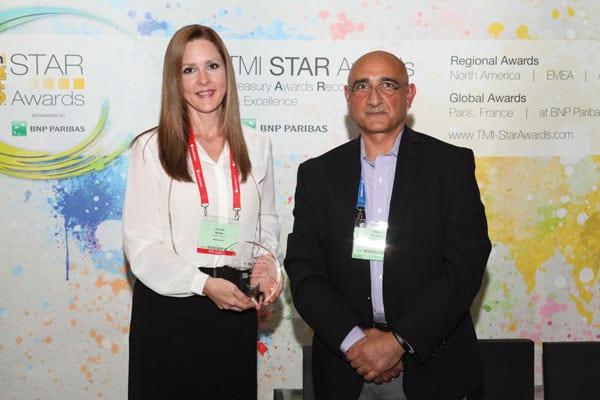
- Jennifer Winkle
- Director of Corporate Finance, Albemarle Corporation
by Jennifer Winkle, Director of Corporate Finance, Albemarle Corporation
In 2015, Albemarle was a distinguished winner of the TMI Star Award for Liquidity Management in association with BNP Paribas, presented at the EuroFinance Conference in Miami. Specifically, the award recognised Albemarle’s success in integrating and optimising liquidity since the acquisition of Rockwood in January 2015. In this article, Jennifer Winkle, Director of Corporate Finance (previously Assistant Treasurer), describes the liquidity objectives of the newly combined group in more detail, and how treasury has achieved them.
Key Points
- Albemarle’s acquisition of Rockwood necessitated the amalgamation of the two treasuries
- Among the first priorities were to optimise liquidity and ensure the credit needs of the newly combined group were met
- The article describes how Albemarle has achieved a global liquidity structure by working with BNP Paribas, BMG and J.P. Morgan, and outlines the group’s plans for further rationalisation and simplification of its account and liquidity structures in Europe
|
|
Treasury background
Albemarle has maintained a centralised treasury organisation for many years. In 2010, the company created a shared service centre (SSC) in Budapest, Hungary to handle day-to-day cash management flows for North and South America and the EMEA region, and another in Dalian, China in 2012 for the Asia Pacific region. Group treasury, based in Baton Rouge, Louisiana, takes responsibility for strategic treasury activities such as financial risk management, corporate finance, relationships with banking partners and rating agencies, M&A, etc. The $5.7bn acquisition of Rockwood, which was announced in July 2014 and completed in January 2015, marked a major change for the group, including treasury. Rockwood’s treasury organisation and culture was fundamentally different from Albemarle. Although there was a small group treasury function based in Princeton, New Jersey, and Frankfurt, Germany, the company had a largely decentralised approach to treasury with each entity responsible for managing its own cash and treasury management requirements and executing transactions.
During the first few months of 2015, we took the time to understand how Rockwood’s treasury operated, and identify the strengths that we could incorporate into the newly enlarged group treasury function. We then started the process of integrating the group treasury function into our Baton Rouge operation, and transferring day-to-day cash and treasury management execution of certain entities to our SSCs.
Diverse liquidity challenges
Albemarle and Rockwood had very different liquidity profiles, and therefore approaches to liquidity management. For Albemarle, the key liquidity challenges were in Europe, where a major portion of liquidity was generated. We had implemented a multi-currency notional pool with Fortis, several years prior to its acquisition by BNP Paribas. This comprised a pool header account in Belgium, with participating accounts in countries such as the Netherlands, France and Germany. As the pool was notional, debit or credit balances were maintained on operating accounts held in the name of each participating entity.
As Rockwood was less centralised, business units maintained local accounts and bank relationships in addition to accounts in a multi-currency notional pool with BMG (part of the ING group). In some cases, physical pools were in place, such as in the United States, UK and Germany, with the header accounts of these pools linked to the BMG notional pool.
The acquisition of Rockwood marked an abrupt change, and the group became highly leveraged, with a debt to EBITDA ratio increasing from around 1.5 to almost 4. Although we remain an investment-grade company, our aim since the acquisition has been to reduce this ratio as quickly as possible. To achieve this, we needed to work quickly to establish a global liquidity structure in order to repatriate cash efficiently and pay down debt. We took the opportunity of the six month window between the acquisition announcement in July 2014 and completion in January 2015 to review and revise Albemarle’s liquidity structures. We had already recognised that Albemarle’s liquidity needs had evolved since putting in place the multi-currency notional pool as the company had become cash-rich across participating entities so no longer received the benefits of a notional pool, and we decided to dismantle the structure earlier in the year.[[[PAGE]]]
With the pending acquisition, it made sense to centralise liquidity physically to repatriate cash wherever possible, and take advantage of better investment opportunities. We worked with our European partner bank, BNP Paribas, to create a new structure that met our needs precisely. This comprised a zero balancing cash pool with a notional pool at the header account level in Belgium, to which we linked a €30m overdraft facility.
This new liquidity structure enabled us to maintain a much lower operational cash balance and manage any surplus liquidity more effectively, but just as importantly, anticipated the needs of the new combined business, as we would be able to link the pool to Rockwood’s notional cash pool. Once the acquisition had closed, we took the header account of our BNP Paribas cash pool and linked it into the BMG cash pool. By doing so, we would be able to transfer cash between the cash pools, and therefore gain complete access to liquidity held by either Albemarle or Rockwood respectively.
We also needed to consider the credit needs of the combined group. Rockwood held $2bn in surplus cash before the acquisition, with no credit lines in place. However, as this cash was needed centrally to repay the bridge portion of the acquisition financing, we needed to make sure that former Rockwood entities had access to funding if required. Most of our credit was in the US through a $1bn revolving credit facility. We therefore linked our US parent company entity to Rockwood’s US cash pool with J.P. Morgan, which was also linked to the BMG cash pool.
A phased approach
As a result, we have rapidly achieved a global liquidity structure that enables us to mobilise liquidity to any entity in almost any location with same-day value, and leverage idle cash to pay down debt, such as commercial paper and term loans. Connecting existing liquidity structures with BNP Paribas, BMG and J.P. Morgan was the most efficient and pragmatic means of satisfying the liquidity needs of the newly combined group but in time, we expect to build on our excellent relationship with BNP Paribas and continue to look for ways to rationalise and simplify our account and liquidity structures in Europe. Before the acquisition, for example, we had 150 accounts, whereas we now have around 400 across a large number of banks. We are therefore drafting a plan to map out the ideal ‘end state’, including accounts, connectivity and liquidity management, including possible structures such as an in-house bank.
As a first step, we are transferring accounts with non-core banks to our panel of 14 relationship banks to concentrate our banking activities wherever possible. In addition, we are considering our liquidity management needs and potential solutions in Asia Pacific, and setting up a supply chain finance programme for Europe and United States to enhance our working capital position and further enable us to deleverage our business.
Wider priorities
To support our liquidity management and wider treasury integration and optimisation initiatives, we are currently implementing a new treasury management system, GTreasury, which Rockwood had started to implement prior to the acquisition. Initially, our top priority was to make use of the system’s daily cash and global cash visibility capabilities, but we have now have expanded this into related areas such as bank account administration, intercompany loan management and bank fee analysis to fully utilise the system’s capabilities in creating process efficiencies. Managing risk is also a key priority for us, especially given the volatility in the market. Albemarle has a balance sheet hedging programme in place and has expanded it to incorporate Rockwood’s exposures since the acquisition as Rockwood previously did not hedge FX risk. We are also compiling a business case for cash flow hedging.
Overall, our liquidity project has been a flagship project for the group and the wider industry on how to achieve a rapid result in optimising liquidity in a pragmatic and cost-effective way. While it is only the first step in a treasury transformation journey, we were able to achieve our objectives quickly, without disrupting or introducing risk into our existing operations. We were honoured to receive the TMI Star Award for Liquidity Management in association with BNP Paribas for this project, and we are delighted to have been recognised as a winner of the Alexander Hamilton Award for Liquidity Management as well.











